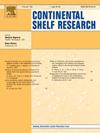Circulation in Cross Sound, Alaska
IF 2.2
3区 地球科学
Q2 OCEANOGRAPHY
引用次数: 0
Abstract
Cross Sound is located in southeast Alaska's Alexander Archipelago and extends ∼50 km eastward from the Gulf of Alaska to Icy Strait. Between May and August 2010, ten moorings were deployed at the entrances to Cross Sound and at key internal locations within the Sound. Instruments on each mooring measured current velocity and temperature; some also measured salinity. The tidal range in this region is large (>5 m), causing high current speeds (peak speed measured at 263 cm s−1), with a strong fortnightly signal. The flow predominantly follows the bathymetry westward from Icy Strait through Cross Sound and into the Gulf of Alaska. Moorings captured an estuarine exchange with outflow near the surface and inflow at depth. Earlier multi-year moorings demonstrated that synoptic variability in water properties is greater in spring and fall than over the summer season. In summer, during spring tides, the water column can mix to the bottom, delivering nutrients into the surface euphotic zone. When spring tides coincided with a strong wind event, bottom temperatures increased by > 1 °C over 3 days.
阿拉斯加克罗斯海峡的环流
十字湾位于阿拉斯加东南部的亚历山大群岛,从阿拉斯加湾向东延伸约50公里至冰海峡。在2010年5月至8月期间,我们在十字湾的入口和主要的内部位置部署了10个系泊系统。每个系泊处的仪器测量了流速和温度;有些还测量了盐度。该地区潮汐差大(5米),导致水流速度高(测量到的峰值速度为263厘米s - 1),每两周有强烈的信号。气流主要沿着水深线向西,从冰海峡穿过十字海峡,进入阿拉斯加湾。系泊捕获了一个河口交换,在接近表面的地方流出,在深处流入。早期的多年系泊表明,春季和秋季的水性质的天气变化比夏季更大。在夏季,在春潮期间,水柱可以混合到底部,将营养物质输送到表面的光区。当春潮与强风事件同时发生时,海底温度升高1℃;1°C, 3天。
本文章由计算机程序翻译,如有差异,请以英文原文为准。
求助全文
约1分钟内获得全文
求助全文
来源期刊

Continental Shelf Research
地学-海洋学
CiteScore
4.30
自引率
4.30%
发文量
136
审稿时长
6.1 months
期刊介绍:
Continental Shelf Research publishes articles dealing with the biological, chemical, geological and physical oceanography of the shallow marine environment, from coastal and estuarine waters out to the shelf break. The continental shelf is a critical environment within the land-ocean continuum, and many processes, functions and problems in the continental shelf are driven by terrestrial inputs transported through the rivers and estuaries to the coastal and continental shelf areas. Manuscripts that deal with these topics must make a clear link to the continental shelf. Examples of research areas include:
Physical sedimentology and geomorphology
Geochemistry of the coastal ocean (inorganic and organic)
Marine environment and anthropogenic effects
Interaction of physical dynamics with natural and manmade shoreline features
Benthic, phytoplankton and zooplankton ecology
Coastal water and sediment quality, and ecosystem health
Benthic-pelagic coupling (physical and biogeochemical)
Interactions between physical dynamics (waves, currents, mixing, etc.) and biogeochemical cycles
Estuarine, coastal and shelf sea modelling and process studies.
 求助内容:
求助内容: 应助结果提醒方式:
应助结果提醒方式:


